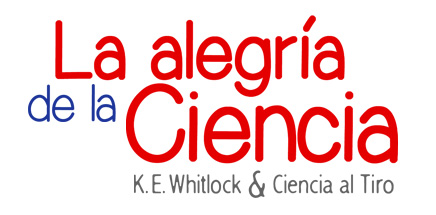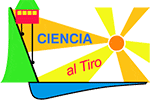Audiovisual project based on the book The Joy of Science, carried out with funding from the XX Explora Project Contest for the Assessment and Dissemination of Science and Technology Projects (2016).

The book The Joy of Science inspired the adaptation of 10 workshops to audiovisual format to relate science to everyday life.
Starring the young Cata, Yuri and Giaco, the videos have high-quality scientific content in an attractive and innovative format, bringing science to the public and generating interest in all age groups to ask questions and experiment.
Actors: María Fernanda Palominos, Giacomo Silva, Yuri Durán
Director: KE Whitlock, Alternate Director: Juan Carlos García, Science evaluation and communication: Isabel Benjumeda.
Script: KE Whitlock, Christian Morales, Production Assistant: Pilar Polanco, Camera: Lucía Pérez, Camera Assistant: Nathaly Dubi Cano, Sound: Amador Providell, Narration: María Fernanda Palominos, Technical Director: Amador Providell, Animation and Post-Production: Alex Rojas, Ximena Cáceres, Original Watercolors: Bettiana Castro, Artistic Director: KE Whitlock.
Below you can see all the episodes of this series.
Aquaponics
A different kettle of fish
Aquaponics has the advantage that being grown in water, the plants grow faster and use feder chemicals compared to traditional crops on land.
What is Aquaponics?
It is a natural system in which plants grow with fish; that is, a combination of hydroponics (plants that grow without soil) and aquaculture (recirculating). In this system, the fish waste provides the nutrients (nitrates) necessary for the plants to grow. The plants clean the water and it is returned to the fish (recirculating). This system is 80% more efficient in water use than traditional agriculture and is healthy because one cannot use antibiotics or pesticides because they will affect plants and / or fish.
What is pH?
PH measures the acidity of a solution on a scale from 0 to 14; a pH of 7 is neutral, below 7 is acidic and above 7 is considered basic. For an aquaponics system an ideal pH is 7.0 because it is a balance between the like plants (like 6.8) and what the fish (like 7.2). It is also a good pH for bacteria and the nitrogen cycle.
What is the Nitrogen cycle?
More than half of the fish waste is ammonia, which is very toxic and is broken down by certain bacteria (nitrosomonas) converting it into nitrite. Nitrite is still toxic to fish but it is transformed into nitrate by another group of bacteria called nitrobacteria. Nitrate is the primary food source for plants and is essential for plants to grow. But in high concentration the nitrate can affect the fish, therefore the plants remove the nitrate this helping the fish.
Biogas
The fart that is not ugly
The energy that we use on a daily basis is obtained mainly from non-renewable resources such as oil, coal and natural gas. Unfortunately these resources have a high economic and environmental cost.
What is Biogas?
When organic waste decomposes (putrefaction) a mixture of gases is released, first methane and carbon dioxide, which is called biogas. Biogas is a very important energy resource and a source of energy that could be used to light the streets or heat houses, but which is not usually used.
How is biogas produced?
Biogas is produced by chemical reactions that result from the degradation of organic matter. This degradation is carried out by anaerobic bacteria (without oxygen). Be Careful! Only biodegradable materials (materials that can be degraded by rapid decomposition by the action of microorganisms) are useful for biogas production.
What is the difference between renewable vs non-renewable energy?
Normally we use energy from non-renewable resources such as oil or natural gas, which are increasingly scarce and are very expensive, both for our budget and for the environment. Organic waste is a source of energy that is not utilized when it could be, as we use wind or solar energy.
Compost
Life-giving garbage
Compost is obtained naturally by the aerobic decomposition of organic waste such as vegetables, fruits, prunings, grasses and used tea bags.
What is compost?
Compost is obtained by the decomposition of organic waste such as vegetables, fruits, prunings, grasses, dry leaves, eggshells and used tea bags. Compost has two main functions: to obtain good quality compost for flowers, trees and orchards and to reduce the amount of waste that is produced in your house and that ends up in landfills, polluting the environment.
Why does compost generate heat?
Compost heat is produced as a by-product of microbial degradation of organic material. Heat production depends on factors such as the size of the pile, its moisture content and aeration.
When can I start using compost?
Your compost will be ready when the temperature has dropped and you have a dark colored material with no visible remains of waste. Remember to stir the mixture every time you add new waste to your compost to distribute the moisture evenly and provide oxygen to the microorganisms that live in it.
What you should not add to compost
Non-biodegradable materials such as plastics, metals, glass, aluminum, diapers, and plastic bags. To avoid attracting animals such as rats, you should not add dairy, leftover meat or fish, eggs, oils, and butter.
Magical Hand Warmer
Hotter than a hot potato
Magic Hand Warmers are flexible and resistant plastic bags. They are filled with a crystalline solution capable of changing state and releasing energy that is perceived as heat.
How is the heat produced in the magicl hand warmer?
Sodium acetate molecules are in supersaturated solution. When you move the metals in the clips, it releases sodium acetate particles that form a nucleation point that begins the crystallization process. You can see the initiation of crystallization with the clips and proceed through the liquid, thereby producing heat.
What is a chemical reaction?
It is the process in which one or more compounds interact to form a product other than the initial one. In the case of magic hand warmers, these compounds are sodium acetate and water. Initially it is a liquid and as a result of the chemical reaction it becomes a solid.
What are the states of equilibrium?
There are two states of equilibrium; liquid and crystallized. These changes of state are used to produce heat in our magic hand warmers.
Compass
Where the buses don’t run
A Compass is a navigational instrument used to find the direction in relation to the magnetic poles of the Earth: the North Pole (Arctic) and the South Pole (Antarctica).
What is a compass?
It is a navigation instrument used to find a location. The compass has a magnetized pointer that usually points North and rotates until it lines up with the Earth’s magnetic field.
What parts does a compass have?
The compass needle that detects the Earth’s magnetic field and points North. The outer ring that can be rotated and that contain numbers (from 0 to 360, expressed in degrees for each cardinal point). The ring also contains the initials of each cardinal point (North, South, East, West). Many compasses have a direction of travel arrow, which should be pointed in the direction you want to go.
How do we use a compass?
In general use a compass in combination with a map to align the north direction of the compass with North indicated on the map.
Solar Electric Energy
All that glitters is gold
Sunlight is a radiant energy made up of particles called photons that strike the extra electrons from the phosphorus atoms in the photovoltaic panel.
How does electricity work?
Electricity begins when electrons in an atom are stimulated and move in a current. Some atoms have their electrons close to the nucleus and some do not easily move or generate a current. Atoms that do not keep their electrons close to the nucleus are best at conducting an electrical current (eg metals such as silver, gold, and copper).
Why silicon?
Many photovoltaic panels are made using silicon, which is the second most abundant element on earth, making it economical and profitable.
A Simple Motor
Go the extra mile
The key to understanding how an electric motor works is to first understand how a magnet works, since the properties of magnets are the basis of how this type of motor works.
How does an electric engine work?
In an electric motor, a battery is used as a supply of electrical current that passes through a conductor (copper wire) and passes through a magnetic field (magnet). The properties of magnets are the basis of how an electric motor works; the electric current and the magnetism of the magnet (attraction / repulsion) are what create the movement of the motor.
Advantages of an electric motor
Trolleybuses run on an electric motor; they convert electrical energy to mechanical (kinetic) energy. These engines are quieter and less polluting than a gasoline engine (such as the one used in buses). Electric motors produce more than 60% of the world’s energy.
Dirty Hands, Clean Hands
As clean as a whistle
Although in some cases the bacteria that live on the skin can cause diseases, most of these are not pathogenic and are even beneficial to humans.
What are bacteria?
Bacteria are microorganisms; very small living things that cannot be seen with the naked eye, so we need a microscope to see them. Bacteria are single-celled microorganisms. They first appeared on Earth about 3.5-4 BILLION years ago and were the first life form to exist on Earth.
Where do we have the largest population of bacteria?
On the skin of the hands is the place where more bacteria live. These bacteria are of very different types but most are not pathogenic (they do not cause infectious diseases).
Why is it important to wash our hands?
Washing our hands with soap before eating or after going to the bathroom helps fight diseases and parasites, so we must wash our hands.
Does soap kill bacteria or just clean bacteria?
It’s actually both, depending on the soap. Some soaps kill bacteria, others just rinse them off.
Solar Oven
The bee’s knees
Solar ovens are easy-to-make devices that allow you to cook food using the sun as an energy source.
What is a solar oven?
It is an easily manufactured device that allows us to cook using the radiant energy of the sun as an energy source.
How do we trap heat?
The basis of the operation of a solar oven is the concentration of heat that comes from the radiant energy of the sun and for that we need to “trap” it. This can be achieved with dark colors, which absorb the color and reflective materials that concentrate the heat inside the oven.
The Thermometer
Dog days of summer
Temperature is a physical quantity that measures the sensation of cold or heat in bodies or the environment.
What is temperature?
It is a physical quantity that measures the sensation of cold or heat in bodies or the environment. It can be measured on two scales; Celsius and Fahrenheit, the latter is more common in the US.
What is a thermometer?
A traditional thermometer consists of a closed glass tube that contains a substance that changes in volume depending on the ambient temperature. Mercury is normally used, which remains liquid between -38.8 and 356.7º C.
How does a thermometer work?
When exposed to heat, the liquid has molecules that move faster at higher temperatures, thus increasing the volume and push it upward.












